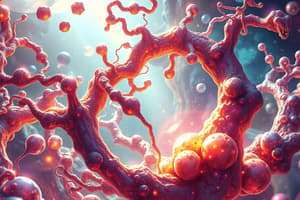Podcast
Questions and Answers
Which one of these is an example of potential energy?
Which one of these is an example of potential energy?
- A spinning top
- A falling leaf
- A moving car
- A stretched rubber band (correct)
Which one of these is an example of an exergonic reaction?
Which one of these is an example of an exergonic reaction?
- Digesting food
- Photosynthesis
- Charging a battery
- Burning wood (correct)
What is the function of enzymes?
What is the function of enzymes?
- To transport oxygen in the blood
- To speed up chemical reactions (correct)
- To store energy in cells
- To regulate body temperature
Which one of these is an example of an anabolic pathway?
Which one of these is an example of an anabolic pathway?
Which one of these is an example of a catabolic pathway?
Which one of these is an example of a catabolic pathway?
Which one of these is the first law of thermodynamics?
Which one of these is the first law of thermodynamics?
Which one of these is an example of an exergonic reaction?
Which one of these is an example of an exergonic reaction?
Which one of these is an example of an endergonic reaction?
Which one of these is an example of an endergonic reaction?
What is the final product of glycolysis?
What is the final product of glycolysis?
Which one of these is an example of a catabolic pathway?
Which one of these is an example of a catabolic pathway?
What is the first law of thermodynamics?
What is the first law of thermodynamics?
What is the function of enzymes?
What is the function of enzymes?
What is the final product of glycolysis?
What is the final product of glycolysis?
What is the citric acid cycle?
What is the citric acid cycle?
What is anaerobic respiration?
What is anaerobic respiration?
Which one of these is an example of an exergonic reaction?
Which one of these is an example of an exergonic reaction?
What is the final product of glycolysis?
What is the final product of glycolysis?
What is the citric acid cycle?
What is the citric acid cycle?
Where does lactic acid fermentation occur?
Where does lactic acid fermentation occur?
What is aerobic respiration?
What is aerobic respiration?
What is anaerobic respiration?
What is anaerobic respiration?
Flashcards are hidden until you start studying
Study Notes
Energy and Reactions
- Potential energy is stored energy due to an object's position or state, such as a rock perched on a hill.
- An exergonic reaction releases energy, for example, the breakdown of glucose during cellular respiration.
- Endergonic reactions require energy input, such as photosynthesis, where light energy is absorbed to form glucose.
Enzymes
- Enzymes serve as biological catalysts that accelerate chemical reactions by lowering the activation energy required.
- They are specific to substrates and are vital for various metabolic processes.
Metabolic Pathways
- Anabolic pathways involve the synthesis of complex molecules from simpler ones, such as protein synthesis from amino acids.
- Catabolic pathways break down complex molecules into simpler ones, releasing energy, like glucose catabolism during glycolysis.
Thermodynamics
- The first law of thermodynamics states that energy cannot be created or destroyed, only transformed from one form to another.
Glycolysis
- The final product of glycolysis is pyruvate, which is produced from the breakdown of glucose.
Citric Acid Cycle
- The citric acid cycle, also known as the Krebs cycle, occurs in the mitochondria and is crucial for producing energy carriers such as NADH and FADH2 from acetyl-CoA.
Cellular Respiration
- Anaerobic respiration occurs in the absence of oxygen and produces less energy than aerobic respiration, which requires oxygen for efficient energy production.
- Lactic acid fermentation, a type of anaerobic respiration, occurs in muscle cells and some bacteria, producing lactic acid as a byproduct.
Summary of Processes
- Aerobic respiration involves the complete oxidation of glucose in the presence of oxygen, generating ATP, carbon dioxide, and water.
- Anaerobic respiration leads to energy production without oxygen, resulting in byproducts like lactic acid or ethanol, depending on the organism.
Studying That Suits You
Use AI to generate personalized quizzes and flashcards to suit your learning preferences.




